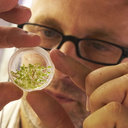Universal stress protein HRU1 mediates ROS homeostasis under anoxia.
Kľúčové slová
Abstrakt
Plant survival is greatly impaired when oxygen levels are limiting, such as during flooding or when anatomical constraints limit oxygen diffusion. Oxygen sensing in Arabidopsis thaliana is mediated by Ethylene Responsive Factor (ERF)-VII transcription factors, which control a core set of hypoxia- and anoxia-responsive genes responsible for metabolic acclimation to low-oxygen conditions. Anoxic conditions also induce genes related to reactive oxygen species (ROS). Whether the oxygen-sensing machinery coordinates ROS production under anoxia has remained unclear. Here we show that a low-oxygen-responsive universal stress protein (USP), Hypoxia Responsive Universal Stress Protein 1 (HRU1), is induced by RAP2.12 (Related to Apetala 2.12), an ERF-VII protein, and modulates ROS production in Arabidopsis. We found that HRU1 is strongly induced by submergence, but that this induction is abolished in plants lacking RAP2.12. Mutation of HRU1 through transfer DNA (T-DNA) insertion alters hydrogen peroxide production, and reduces tolerance to submergence and anoxia. Yeast two-hybrid and bimolecular fluorescence complementation (BiFC) analyses reveal that HRU1 interacts with proteins that induce ROS production, the GTPase ROP2 and the NADPH oxidase RbohD, pointing to the existence of a low-oxygen-specific mechanism for the modulation of ROS levels. We propose that HRU1 coordinates oxygen sensing with ROS signalling under anoxic conditions.


